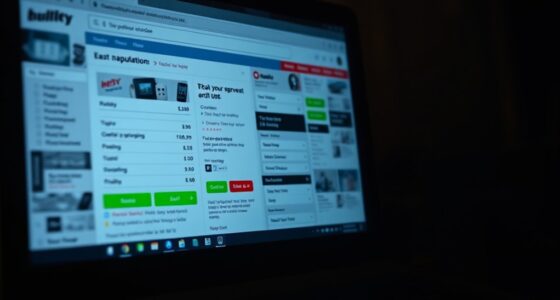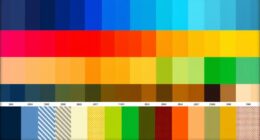To maximize your call-to-action effectiveness, place your CTAs where users naturally focus, like above the fold or near high-engagement content. Use contrasting colors, clear messaging, and visual cues to guide attention. Incorporate multiple CTAs strategically throughout your page, especially on mobile devices, and test different placements to see what works best. Continuously analyze performance to refine your approach. Keep reading to discover top strategies that guarantee your CTAs boost engagement and conversions.
Key Takeaways
- Place CTAs above the fold for immediate visibility and ensure they align with user intent.
- Use visual hierarchy, contrast, and directional cues to make CTAs stand out naturally within content.
- Position CTAs near high-engagement content or after compelling sections to sustain user momentum.
- Optimize placement for mobile devices, focusing on thumb-friendly zones and touch-friendly design.
- Continuously test and analyze different placements and designs to refine effectiveness based on performance metrics.
Understanding User Behavior and Attention Patterns
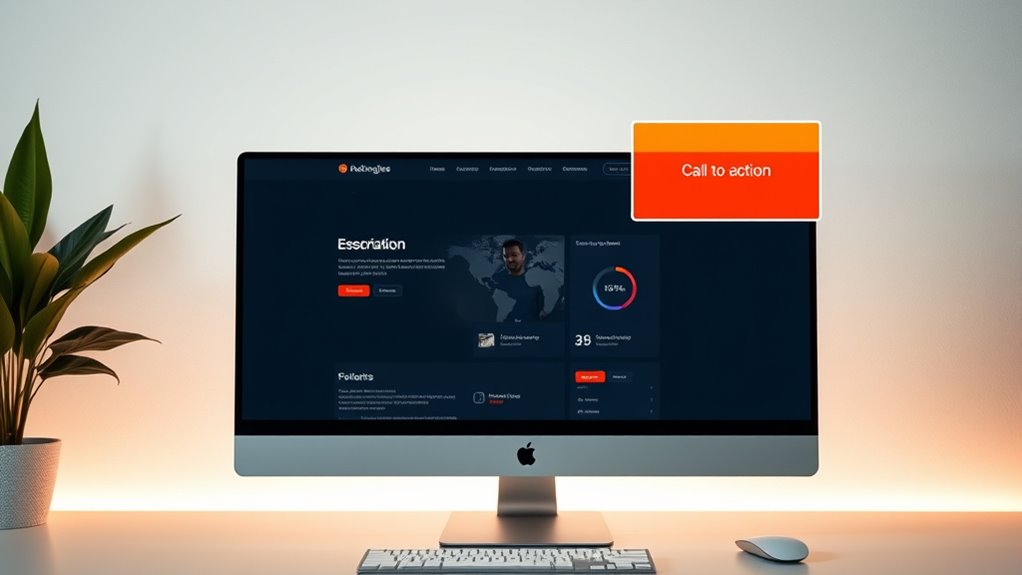
Understanding how users behave and where their attention naturally focuses is essential for placing effective calls-to-action. Eye tracking studies reveal that users typically scan web pages in an F-shaped pattern, focusing most on the top and left areas. Your audience’s attention span also influences engagement; it’s usually brief, so capturing their focus quickly matters. By analyzing eye tracking data, you can identify high-visibility spots where users naturally look, helping you position CTAs where they’re most likely to see them. Recognizing these attention patterns allows you to optimize placement, ensuring your calls-to-action catch the eye before users lose interest. Additionally, visual hierarchy plays a crucial role in guiding user attention toward your CTAs naturally. This understanding helps you design more compelling, strategically positioned CTAs that align with natural user behavior, increasing your chances of conversion and engagement. Incorporating knowledge of vibrational focus from the Law of Attraction can further enhance your placement strategies by aligning your messaging with what captures subconscious attention, leading to more effective engagement. Recognizing the importance of natural attention patterns can further refine your approach to placement.
Placing CTAs Above the Fold for Immediate Visibility

Placing your calls-to-action above the fold guarantees they’re immediately visible when visitors land on your page. To maximize impact, establish a clear visual hierarchy so your CTA stands out. Use size, placement, and spacing to draw attention. Incorporate strong color contrast between the CTA button and the background, making it pop and catch the eye instantly. This contrast guides visitors’ focus directly to the action you want them to take. Keep the design simple and uncluttered, ensuring the CTA isn’t lost amid other elements. By prioritizing above-the-fold placement with strategic visual hierarchy and effective color contrast, you ensure your CTA is seen right away, increasing the likelihood of engagement and conversions from the moment visitors arrive. Additionally, understanding visual hierarchy can help you guide visitors’ attention more effectively and improve overall conversion rates. Recognizing the importance of digital resources like apps and newsletters can further enhance user engagement and support your call-to-action strategies. Utilizing skilled design principles can also ensure that your placement strategies are both effective and visually appealing. Incorporating user behavior insights can help optimize placement for different audiences and devices, ensuring your CTA remains prominent across platforms.
Incorporating CTAs Within Content for Contextual Relevance
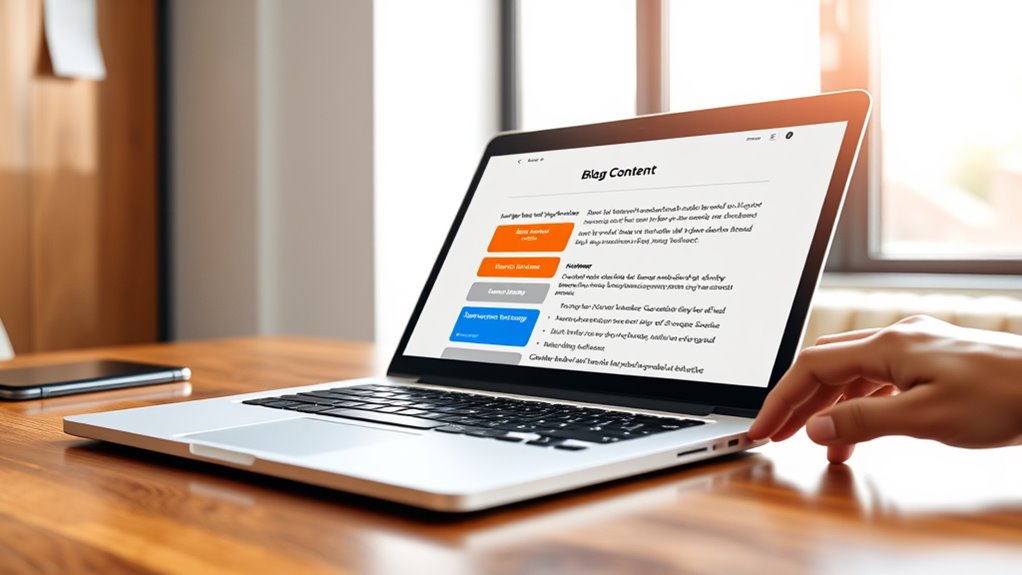
To make your CTAs more effective, you need to integrate them smoothly within your content, ensuring they feel like a natural part of the message. Strategic placement is key—you want your CTAs to appear where they match the reader’s intent and engagement. By focusing on seamless content integration and thoughtful positioning, you increase the chances of driving action. Incorporating trending styles like bold, bright colors can also enhance the visual appeal of your calls to action. Additionally, understanding the types of honey and their unique benefits can help tailor your messaging to resonate more effectively with your audience. Leveraging content placement strategies can further streamline your content strategy, making your CTAs more targeted and impactful. Recognizing signs of high spiritual energy can also inspire more meaningful engagement, encouraging readers to take action aligned with their personal growth.
Seamless Content Integration
Incorporating calls-to-action (CTAs) seamlessly within your content guarantees they feel natural and relevant, rather than disruptive. To achieve this, focus on content relevance—embed CTAs where they naturally align with the topic and flow of your material. This keeps your audience engaged without causing user distraction. When CTAs blend smoothly into the narrative, readers are more likely to respond positively because the call feels like a helpful next step rather than an interruption. Use contextual cues and relevant phrasing to connect your CTA to the surrounding content. This approach enhances the overall user experience, guiding your audience toward action without breaking their reading flow. Additionally, understanding Bedroom decor can help you tailor your messaging to better resonate with your target audience. Recognizing the costs of divorce in Florida allows you to address financial concerns effectively, making your CTA more impactful. Seamless integration ensures your CTAs support your goals while maintaining clarity and engagement.
Strategic Placement Techniques
While many overlook the importance of strategic placement, placing CTAs thoughtfully within your content can substantially boost engagement and conversions. To do this effectively, consider the visual hierarchy—highlighting call to action zones where users naturally focus. Position CTAs near relevant information to maximize relevance and motivate action. Use clear spacing and contrast to make your CTAs stand out without disrupting flow. Incorporate them at key points like after compelling arguments or during moments of high engagement. Remember, well-placed CTAs guide your audience seamlessly toward your goals. Additionally, understanding your audience’s organization habits can help you identify the most effective locations for your CTAs. Regularly analyzing your campaign performance metrics can further refine your placement strategy for improved results, especially by observing how relationship dynamics influence user engagement patterns. Incorporating insights from content engagement data can also help optimize CTA placement for better outcomes. Recognizing divorce trends and how they affect user interest can further tailor your CTA placements for maximum impact.
Using Multiple CTAs Strategically Throughout Your Page
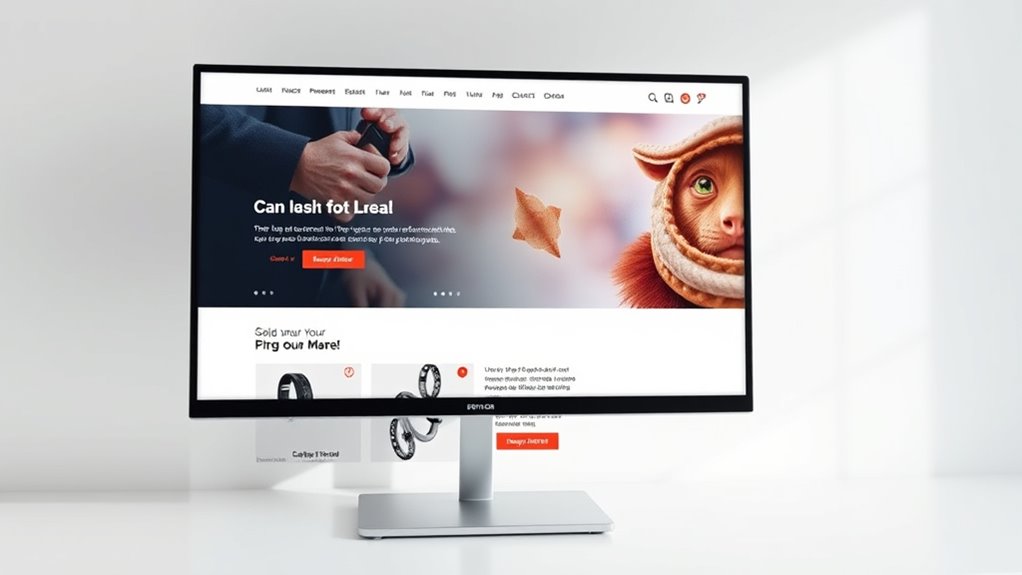
Strategically placing multiple calls-to-action (CTAs) throughout your page can substantially boost engagement and conversions. To do this effectively, consider the visual hierarchy—ensure each CTA stands out appropriately without overwhelming the user. Use color psychology to select hues that evoke the desired emotional response and guide visitors naturally toward taking action. Place CTAs at key points, such as after compelling content or important sections, to maintain momentum. Varying the design and placement helps capture attention without causing confusion. Remember, each CTA should have a clear purpose and be visually distinct, yet consistent within your overall design. This strategic distribution keeps users engaged and increases the likelihood of conversions by guiding them smoothly through your page’s flow. Incorporating visual hierarchy principles ensures your CTAs are both noticeable and effective. Additionally, aligning your call-to-action with the overall message enhances clarity and motivation for users to act.
Leveraging Visual Cues and Design Elements to Highlight CTAs
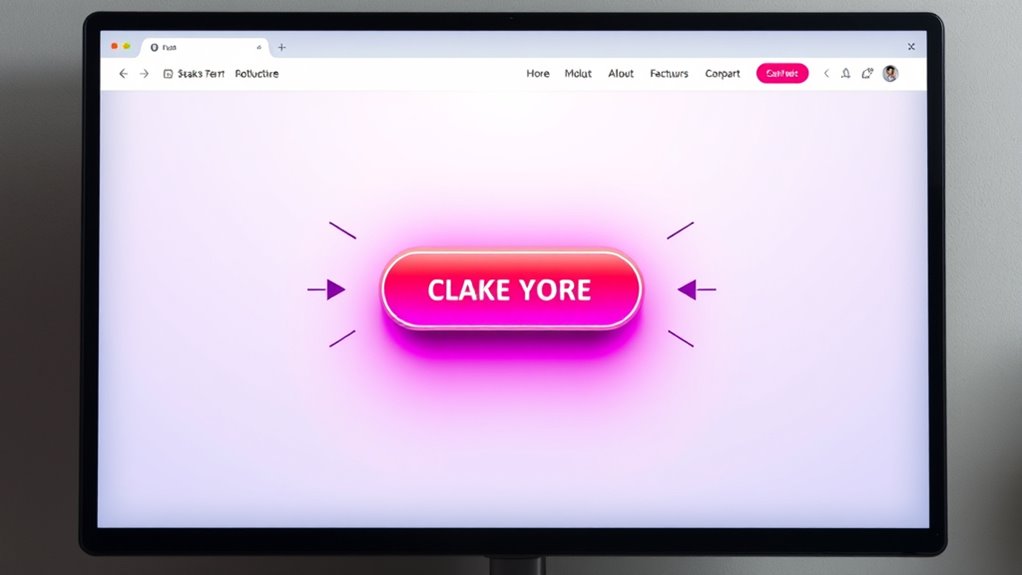
Using visual cues and design elements effectively can make your CTAs stand out and guide visitors seamlessly toward taking action. You can achieve this by establishing a strong visual hierarchy, ensuring your CTA draws immediate attention. Utilize color contrast to make your buttons pop against the background, making them impossible to miss. Clear borders, whitespace, and strategic placement also help direct the eye naturally to your CTA. Remember, consistency in style reinforces importance, so use similar design elements across your site. To maximize impact:
Effective visual cues and contrasts make your CTAs impossible to miss and naturally guide visitors toward action.
- Use bold colors for your CTA that contrast with surrounding content
- Incorporate directional cues like arrows or lines
- Position CTAs where users naturally focus, such as above the fold
Leveraging these design elements makes your CTAs more compelling and action-oriented.
Timing Your CTAs Based on User Engagement Points

To maximize your CTA’s effectiveness, you need to recognize key engagement milestones your users hit. Align your CTAs with their actions to guarantee they appear when interest is at its peak. Timing your CTAs just right can considerably boost conversion rates and user satisfaction.
Recognize Engagement Milestones
Recognizing key engagement milestones allows you to time your calls-to-action (CTAs) more effectively. When you identify moments like deep content consumption or interaction with visual hierarchy, you can strategically place CTAs to maximize impact. These milestones indicate genuine interest, making your CTA more relevant and compelling. Incorporate brand storytelling at these points to deepen connection and prompt action. Pay attention to how users navigate your content—if they linger on certain sections or engage with visuals, it’s a prime opportunity to introduce a CTA. By aligning your CTAs with these engagement signals, you boost conversions and enhance user experience.
- Track user interactions that indicate interest, like scrolling or clicks
- Use visual hierarchy cues to identify prime moments for CTAs
- Leverage brand storytelling to deepen engagement and prompt action
Align With User Actions
Timing your calls-to-action effectively hinges on aligning them with the precise moments when users are most engaged. You can achieve this by understanding user psychology and leveraging visual hierarchy to guide attention. When users are actively interacting—scrolling, clicking, or spending time on key content—they’re most receptive to your CTA. Position your CTAs where visual hierarchy naturally directs focus, such as after compelling headlines or high-value content. Recognizing these engagement points allows you to place CTAs at moments when users are primed to respond, increasing conversion chances. By aligning your CTA timing with user actions, you ensure they feel relevant and timely, rather than intrusive or out of context. This strategic sync boosts engagement and drives users toward desired outcomes effectively.
Time for Peak Interest
Understanding when users are most interested in your content allows you to strategically place your calls-to-action for maximum impact. Timing considerations are vital for capturing user attention at the right moment. By identifying key engagement points, you can deliver your CTA when users are most receptive. Look for moments such as after explaining a benefit, solving a problem, or when curiosity peaks.
- Monitor how users interact with your content to identify these moments
- Use analytics to track engagement spikes and adjust CTA placement accordingly
- Test different timings to find what best captures user attention and drives action
Focusing on timing considerations ensures your CTAs align with user interest, increasing the likelihood of conversions and engagement.
Optimizing CTA Placement on Mobile Devices

Since most users access websites via mobile devices, placing your call-to-action (CTA) where it’s immediately visible is crucial. Consider integrating gesture-based interactions, such as swipes or taps, to make the CTA easily accessible without cluttering the screen. Position your CTA near the top of the page or within thumb-friendly zones to ensure quick visibility. Voice command prompts can also enhance mobile engagement by allowing users to activate the CTA hands-free, especially when they’re on the go. Keep the CTA prominent and simple, avoiding hidden links or small buttons that are hard to tap. By optimizing placement with these mobile-specific interactions, you increase the chances of user engagement and drive conversions effectively.
Testing and Analyzing CTA Positions for Maximum Impact

To guarantee your CTA placements deliver maximum impact, you need to rigorously test and analyze their performance. Experiment with different button colors to see which attract more clicks, as color profoundly influences user engagement. Adjust font size to ensure your CTA stands out without overwhelming the content—finding the right balance boosts visibility. Use A/B testing to compare placements, tracking click-through rates and conversions for each variation. Monitor how changes in button color and font size affect user interaction, and be ready to iterate based on data. Regular analysis helps you identify the most effective positions and design elements. Remember, small tweaks can lead to big results in conversion rates, so stay attentive to performance metrics. Keep testing until you find what truly drives action.
Aligning CTA Placement With Overall Conversion Goals
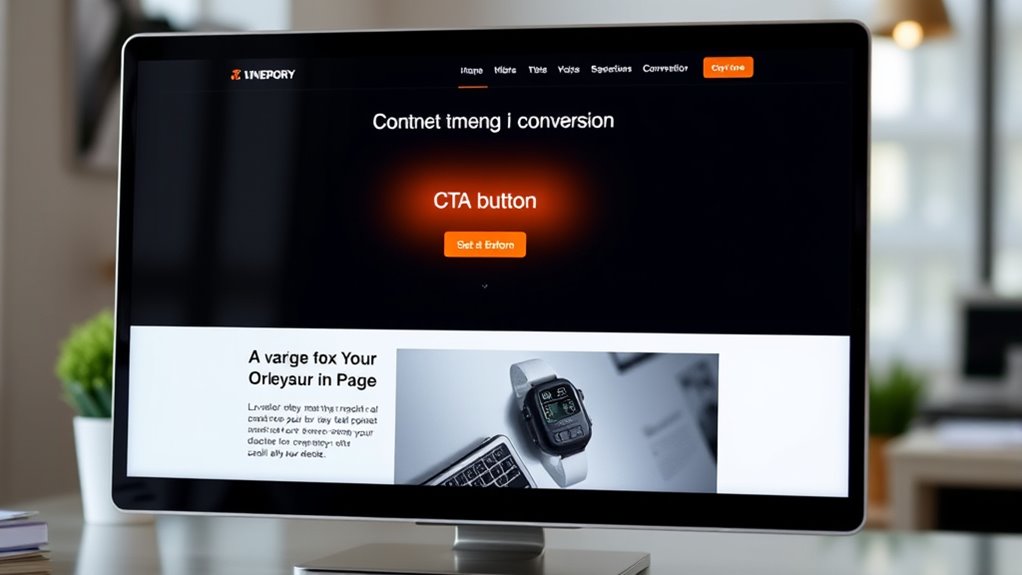
To maximize your conversions, you need to place CTAs where they support your overall goals. Use strategic placement techniques that align with your messaging and guarantee consistency across your content. Integrate relevant conversion metrics to measure how well your CTA placement drives results.
Strategic Placement Techniques
Aligning your CTA placement with your overall conversion goals requires careful planning and strategic thinking. To maximize effectiveness, consider how visual hierarchy guides users’ attention and how color psychology influences their actions. Position your CTA where it naturally fits within the user journey, such as after providing value or solving a problem. Use contrasting colors to make your CTA stand out, leveraging color psychology to evoke specific emotions—like trust or urgency. Make sure your placement aligns with your conversion goals, whether it’s capturing leads, encouraging purchases, or sign-ups. Remember, strategic placement isn’t just about location—it’s about creating a seamless flow that directs users toward your desired outcome.
- Prioritize high-traffic areas based on user behavior
- Use visual hierarchy to emphasize key CTAs
- Apply color psychology strategically for emotional impact
Consistent Messaging Alignment
Ensuring your CTA placement supports your overall conversion goals requires integrating your messaging seamlessly across your user journey. Achieving branding consistency is key—your CTA should reflect your brand’s voice, style, and values, creating a unified experience. When messaging aligns, your audience perceives your site as trustworthy and professional, increasing engagement. Visual harmony also plays a critical role; your CTA should blend naturally with your page design, avoiding disruption or confusion. Consistent messaging reinforces your core value proposition and guides users toward desired actions without ambiguity. By maintaining coherence between your messaging and visual elements, you foster a seamless user experience that aligns with your conversion objectives. This alignment helps build trust and encourages users to follow through on your calls to action effortlessly.
Conversion Metric Integration
Integrating your CTA placement with your overall conversion metrics guarantees that every element on your site works toward measurable goals. To do this effectively, focus on aligning your CTA with key performance indicators like click-through rates or conversions. Use A/B testing to experiment with different placements and identify what drives the best results. Pay attention to your visual hierarchy—placing CTAs where users naturally focus increases engagement. Regularly analyze data to refine your strategy, ensuring your CTA placement supports your broader conversion objectives. Remember, small adjustments based on metrics can markedly boost your success.
- Test different placements with A/B testing to optimize results
- Use visual hierarchy to guide visitors’ attention to your CTA
- Continuously analyze metrics to refine your strategy
Avoiding Common Placement Mistakes to Enhance Performance
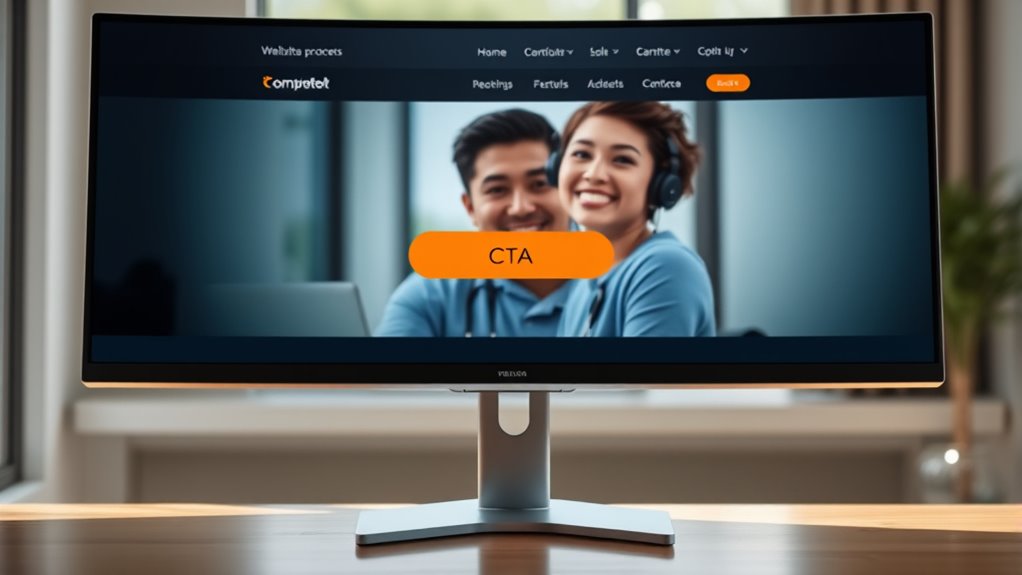
Many marketers make the mistake of placing call-to-action buttons in locations that don’t catch attention or disrupt the user experience. Poor placement can undermine your efforts, so focus on positioning your CTA where it naturally fits within the design aesthetics. Avoid placing buttons too high or too low on the page, which can cause users to overlook them. Instead, use color psychology to make your CTA stand out—bright, contrasting colors draw attention without clashing with your overall design. Keep the placement intuitive and seamless, ensuring it guides users toward action without feeling intrusive. By avoiding these common mistakes, you enhance your chances of engagement and improve overall performance. Remember, strategic placement is key to turning visitors into conversions.
Frequently Asked Questions
How Do I Determine the Best CTA Placement for Different Audience Segments?
You should analyze your audience behavior to determine the best CTA placement for different segments. Use personalization strategies to tailor your CTAs, placing them where your audience is most engaged. Experiment with different positions, like top, middle, or end of your content, and monitor response rates. By understanding each segment’s preferences, you can optimize CTA placement for maximum engagement and conversions.
What Are the Signs That My Current CTA Placement Isn’t Effective?
You might notice your CTA isn’t working if visitors overlook it, despite your efforts. Look for signs like low click-through rates, poor engagement, or users missing visual cues. If your CTA blends into the background or doesn’t leverage color psychology effectively, it’s a red flag. These indicators suggest your current placement isn’t grabbing attention. Adjust by enhancing visual cues and experimenting with colors to make your CTA stand out more.
How Does CTA Placement Vary Across Different Website Types or Industries?
You should consider how CTA placement varies across different website types or industries because industry-specific design and user behavior patterns influence where your CTA should go. For example, e-commerce sites often place CTAs near product details or checkout, while blogs might position them at the end of articles. By understanding these industry nuances, you can optimize your CTA placement to better engage users and boost conversions.
Can Poor CTA Placement Negatively Impact Overall Website Usability?
Poor CTA placement can definitely hurt your website’s usability by disrupting visual hierarchy and distracting user attention. When your CTA isn’t strategically positioned, visitors may overlook it or become confused about what action to take next. This reduces engagement and increases bounce rates. To improve usability, make sure your CTA is prominent and logically placed, guiding users smoothly through your site and aligning with their visual focus points.
What Tools or Software Can Assist in Testing CTA Placement Effectiveness?
You can use tools like A/B testing platforms and heatmap analysis software to test CTA placement effectiveness. A/B testing lets you compare different placements to see which performs best, while heatmaps show where users click most often. These tools help you make data-driven decisions, optimize your website layout, and improve conversion rates by ensuring your CTAs are strategically positioned where visitors are most engaged.
Conclusion
Did you know that placing a CTA above the fold can boost conversions by 20%? By understanding user behavior, strategically positioning your CTAs, and continuously testing, you can profoundly improve engagement. Remember, mobile users make up over half of web traffic, so optimize for smaller screens. Stay focused on your goals, avoid common mistakes, and watch your conversion rates grow as you refine your placement strategies. Your perfect CTA placement is just a test away!





